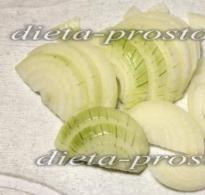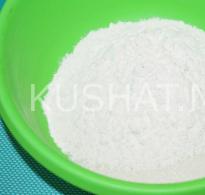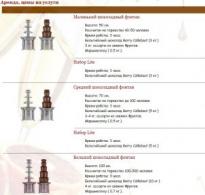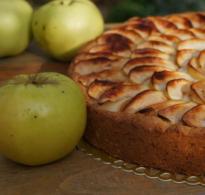How to make moonshine from apricots. Recipes for self-made moonshine from apricots
Apricot moonshine is the most popular distillate in the world. Brandy (rakia, schnapps) is made from this fruit all over the planet - from the Middle East and the Caucasus to the States, Germany and the Balkans. Some connoisseurs put this drink higher than many vintage cognacs.
Apricot is very reluctant to release juice and contains a large number of pectins. Despite this, they prepare different types alcoholic beverages: liqueurs, liqueurs, tinctures, wines, etc. And the best of them is home-made moonshine from apricots. A simple method of preparation and provides him with such popularity. When forcing, the aroma and flavor of the fruit is concentrated and turned into an amazing product. It becomes especially elegant and thin after a long exposure. From the article you will learn how to make moonshine from apricots at home. So let's get started.
Main problems
Apricot belongs to the Plum genus. Therefore, the main problem this fruit for the moonshiner and winemaker, this is the pectin contained in the fruits. It pulls together the fibers of plants, makes the mash cloudy (the distillate obtained from it), prevents the juice from separating and promotes the formation methyl alcohols. The latter are not needed at all in apricot brandy.
Mining methods
So, in order not to leave the precious juice in the squeezes and quickly get it in full, you should use the following methods:
- pectolytic enzymes. There are quite a few of them. For example, "Depectyl", "Clarification", etc. But it should be borne in mind that after processing with the enzyme, the wort will need to be reheated.
- diffuse method. Rough extraction is used, followed by infusion in warm water for several hours. In this case, as much water is taken as indicated in the recipe.
- Heating the wort for 20-30 minutes (temperature 60-70 degrees).
But there is one nuance that is worth mentioning. In all three methods the mash will ferment on CKD (pure yeast culture). They are used specifically for fruit wines. If there is a desire to make the most in a simple way, then apricots cannot be washed and heated. Over time, they will independently ferment into the must on the so-called natural, wild yeast. But it should be borne in mind that without yeast, moonshine from apricots is prepared much longer and it turns out less. The maximum it ferments up to 14-15 degrees. with bakeries and alcohol yeast the process is greatly accelerated. However, the resulting product will have a clear moonshine aftertaste, which is quite difficult to get rid of. Let's go further.

Braga from apricots for moonshine
This simple, basic recipe is based on wild yeast. And it is necessary to act according to the “red” technology, that is, when the must ferments along with the pulp.
The amount of added sugar is self-adjusting. For example, if very sweet fruits are caught, then you can put it less than indicated in the recipe. Apricot moonshine is also made without sugar. But in this case, it will come out very little. On the other hand, if you overdo it with a sweet additive, you will get not apricot brandy, but ordinary sugar moonshine. And it is always important to pay attention to the presence of fructose (about 150 grams per liter). Taking it into account, the sugar content in the wort should not exceed 25% during the fermentation of the drink with wild yeast. If this percentage is exceeded, then the mash simply will not ferment.
Ingredients and must
Moonshine from apricots without yeast should be made in compliance with the following optimal and proven proportions:
- 10-12 liters of water;
- 4 kilograms of sugar (to speed up the process must be inverted);
- 2 buckets of ripe apricots.
Before preparing the wort, all the fruits are sorted. Moldy and rotten parts are cut off, and the bones are removed. If they are not removed, then the moonshine mash will have an almond flavor. If, on the contrary, you love him, then the bones should be added later - immediately after the first run.
The fruits are crushed with a pusher or hands. Sugar and water are added to the resulting mass, mixed well, poured into a container with a wide neck, covered with gauze and placed for 2-3 days in a dark place. During this time, a hat of pulp will appear on the wort. It must be knocked down and periodically stir the whole mass with a wooden spoon. After a couple of days of fermentation, the wort will be ready, and it can be put under a water seal.

Another homemade apricot moonshine recipe
By preparing the wort using a different technology, you can get lighter mash. As a result, moonshine from apricots will become more noble and pure. To do this, add a third of sugar and a third of water to all fruits. Further, everything is warmed up until homogeneous mass and bred in the manner described above. After 2-3 days, it is necessary to drain the resulting liquid and squeeze the pulp well. After diluting with the remaining sugar and water, placing under the shutter.
The resulting wort is poured into a suitable container - plastic barrel or a bottle - and put under a glove or under a water seal for rapid fermentation. Depending on the density of the mash, the sweetness of the fruit, temperature and other circumstances, this process lasts from a week to a month. On CKD everything goes faster. The readiness of the mash can be determined by the shutter: it stops blowing bubbles.
Of course, one cannot be one hundred percent sure that the mash has not burnt to the bottom of the cube (the only exceptions are the owners of steam generators). Therefore, if driven not by steam, but by the standard method, then the mash must be separated from the pulp by filtering and pressing. Well, for complete purity, you need to use one of the cleaning methods, which we will briefly list below.
Lightening Methods: Gelatin
This is one of the best means getting rid of mud. For 10 liters of moonshine, you need from 0.5 to 2 grams of natural, high-quality gelatin. Before pasting, it is soaked in 5-10 times the amount of water for 2-3 hours. Then add the same amount of boiling water and mix thoroughly. The result should be a gelatin solution without lumps with a temperature of 35-40 o C.
Then it is poured in a thin stream into the moonshine and at the same time the drink is constantly stirred. Then the resulting mixture is poured into a vessel, tightly sealed and settled in a dark place for two to three weeks until precipitation occurs.

Egg white
To clarify 50 liters of moonshine, just one is enough egg white. For 100 liters, take 2-3 pieces. It is very important that the eggs are fresh. The protein is carefully separated from the yolk and lightly whipped into foam with a little water. The resulting solution is poured into moonshine and mixed thoroughly. After that, a water seal is installed on the container and the drink settles for 2-3 weeks.
Isinglass
For 100 liters of moonshine, 1.5-2 grams of selected catfish glue is enough. It must be soaked in cold water, which changes until the adhesive granules are completely swollen. After a little it is necessary to heat and pour on these granules.
When the glue disperses, it must be filtered through the flannel. This will help get rid of lumps and various impurities. Then the rest of the moonshine is poured in and mixed thoroughly. After 2-3 weeks, the sediment completely falls out.
Milk (casein)
Some quite successfully lighten moonshine with this particular liquid. For 1 liter of drink, 1 tsp is taken. skimmed milk. Then everything is thoroughly mixed and settled for several days until a precipitate forms.

First distillation
Any distillation apparatus that can operate in distiller mode is suitable for it. The process is carried out with the maximum supply of water and at maximum temperature. By the way, this rule applies to all fruit brews. To prevent splashes from entering the product, a dry steamer must be installed in front of the refrigerator. Well, and, of course, you should not fill the tank more than 2/3 of its volume.
The distillation is carried out almost to dryness and ends when the fruity smell is no longer felt in the tailings. If you are afraid of methyl alcohol, you can select several heads already at the first pasture (with our amount of ingredients, this is about 100 ml.). From the indicated volume of fruit, about 5-7 liters of moonshine from apricots with a strength of 30-40 degrees are obtained.
Then pervach should settle for several days. If the distillate is too cloudy, you can additionally pass it through a carbon filter. But according to the assurances of people who know how to make moonshine from apricots at home, this will negatively affect the aroma of the drink. Although this can be fixed.
If, after the initial distillation, the moonshine came out not aromatic enough and fruit notes are poorly felt in it, it is worth throwing a few drinks into the jar for the “rest” time. fresh apricot ov. Well, to make moonshine light almond note, like the famous Amaretto liqueur, raw alcohol is specially insisted on apricot kernels(3-4 broken kernels per litre). At redistillation contained in them hydrocyanic acid decomposes to aromatic compounds. But you should be careful - not everyone will like the aroma of almonds.

Redistillation
To prepare quality moonshine from apricots at home, just one distillation is not enough. A repeated one is definitely needed, and it is produced fractionally: with cutting off heads rich in volatile alcohols (methylene and others) and containing fusel oils tails. If necessary, the raw material is diluted before distillation to 30 degrees. The diluted liquid is poured into the tank with the heating turned on at minimum power. The optimal distillate output rate is 2-3 drops per second.
Finished fractions are taken in an amount of 5-10% AC - this is approximately 250 ml per volume. The selection of the body can begin after the dripping liquid ceases to smell like acetone. "Heads" are not used. They can be used to disinfect equipment or simply poured out.
During the selection of the "heart" heating should be slightly increased. Pumping continues after reaching 50 degrees in the jet. At this moment, a bad-smelling “mutnyak” will drip from the apparatus, which is the tail fractions. They can also be driven dry and used during next preparation apricot brandy.
When the "tails" are on the way and the strength of the moonshine drops, it is worth removing head fraction and put other dishes under the refrigerator. Then the drink is added to the body literally 200-300 ml each until it has lost its fruity aroma and become cloudy.
Everything, moonshine from apricots, the recipe of which was presented above, is ready! But you can use it only after it settles in glassware two weeks. Well, it would be useful to dilute it first clean water up to about 40-45 degrees. And to turn moonshine into apricot brandy, you need to infuse the drink in a barrel. In the absence of a barrel, a simple and cheap alternative is quite suitable - oak chips. You need to put it a little - there is only one 10-cm chip per liter of moonshine. It is not recommended to exceed this amount, as the drink can turn into an unpleasant-tasting “stool”. Well, it’s worth keeping longer - at least two months.

Finally
Now you know the recipe for moonshine from apricots at home. As you can see, there is nothing supernatural in its preparation. Neither virtuoso skills nor sophisticated equipment are needed. All you need is a desire and a sincere love for fruit distillates, which are rightfully considered the real elite among homemade drinks!
It is impossible not to love apricots: this bright orange fruit color, aroma and taste - the hottest sunny summer. From year to year, the yield of apricot trees varies. Sometimes a capricious southerner drops flowers in spring and refuses to please the owners, and sometimes, under the most unfavorable conditions, he suddenly gives birth to such a crop that poor gardeners don’t know what to do with him. Jam, jams, dried apricots ... Here's another great idea - from apricots. Few people are lucky enough to make this marvelous drink, but since we got lucky - we try!
Interesting: it is believed that apricots spread around the planet from Armenia. It is not for nothing that in other countries this fruit was called “Armenian apples”.
Features of making homemade alcohol
If you decide at home normal conditions make moonshine from this delicious fruit, you should know about it  features. taste buds we are not deceived - this fruit contains an average of about 18% sugars, in a wild game (zherdel) - about 8%, which is also not bad.
features. taste buds we are not deceived - this fruit contains an average of about 18% sugars, in a wild game (zherdel) - about 8%, which is also not bad.
From apricots it turns out, though thick, but still juice, and not mashed potatoes, like or, so you can limit the amount of water in the wort. When adding water, add sugar to bring the sugar content of the future mash to 20%. The pits of ripe fruits are easily separated, the skin is thin, so it is not difficult to process apricots.
Recipes
In the countries of the Balkan Peninsula, “Armenian apples” are used to make a delicious and very popular drink among tourists - raki kaysieva. It is received single or followed. Why not make this apricot moonshine at your home distillery?

- ripe apricots ( cultivar) - 25 kg;
- prepared water - 75 liters;
- sugar - 20 kg;
- - 200 gr.
Cooking steps

The drink should be allowed to rest for several days, and it can be drunk cold or slightly warmed. As an appetizer - meat and cheese cuts.
- If first from apricots, and only from it to make mash, then you can almost not add yeast. Get fragrant and pure moonshine from apricots, which does not have to be distilled twice. About 6 liters of juice with a sugar content of about 10%–15% will come out of 10 kg of fruit. Required:
- apricots - 20 kg;
- sugar - 1.5 kg;
- - 100 gr.
Important: the juice from the perch may have an undesirably high level of acidity (standard - 1%). It can be overridden by adding soft water in a ratio of 1: 1 or pour another juice with a low acid content - apple (from domestic varieties has an acidity of 0.2%), peach (0.4%), cherry (0.4%).

Moonshine from apricots
Do not wash the apricots, remove the pits and squeeze for juice. From sugar we make saturated sugar syrup(0.7 water and 1.5 sugar), cool to + 30 ° C, pour into juice. We breed yeast, wait for the appearance of abundant foam and pour it into the wort. We put to wander in a warm place (t about + 25 ° C). Estimated turnaround time is 10 days. We distill on a single distiller and enjoy the marvelous aroma.
heavenly drink
The taste of cool apricot moonshine is a reminder of a light seaside breeze, warm nights, and summer. Well, if you want even more heat, then do as the Bulgarians do: add caramel or burnt sugar, A little orange peels, a couple of clove buds and a piece of cinnamon stick and heat (do not boil!) in a Turk. A cold dank evening will instantly take on the shade of a holiday.
Most delicious drinks obtained during the distillation of apricot mash, as it has a pleasant, delicate aroma, which is very well communicated to moonshine. Personally, I love making moonshine from apricot, the recipe of which I will give below, because it is simple and affordable. From just three fruit trees of middle age, you can collect up to 30 or even 40 kilograms of carrion after a flashing thunderstorm. Of course, a part can be used for making jam, eating in fresh but there will always be an excess.
So, unlike the same apple, an apricot is a large fruit with very tender pulp, so you can peel it and mash it into a puree with your hands very quickly and easily. Its sugar content is quite high - 12-14%, while sucrose breaks down better into alcohols and secondary products during the fermentation process than artificial sugar.
Recipe for apricot mash for moonshine
The proportions of the ingredients are as follows:
- 1 part apricot pulp
- 1 part water
- 1 kg of sugar per 10 liters of the resulting mixture
- 50 grams of yeast per 1 kg of sugar
It's simple - we mix pitted apricot puree one to one with water, that is, we take 10 liters of water for 10 kilograms of pulp. Mix well, add sugar and yeast dissolved in water, and then traditionally send to bask in the sun.
Important ! It is not always necessary to add sugar to apricot mash. If you want to get a good, fragrant chacha, then adding sugar to the mash is strictly prohibited! Yes, the yield will be lower, but the quality of the product will be much higher.
And here it is important to take into account one more point. If you do not add sugar to the apricot mash, then do not add yeast either. The fermentation process must take place naturally so it will take more time. If the raw materials with yeast are ready for distillation already after 7-8 days, then with natural fermentation it will take twice as much - about 15 or even 20 days.
Apricot moonshine - recipe and subtleties of distillation
If you decide to get really high-quality chacha, then give up sugar and yeast, and adjust the recipe as follows:
- 3 parts apricot puree
- 2 parts water
- 1 part peach puree(in the presence of)
Peach will give the drink a contrast, make the taste more pronounced. But in its absence, you can get by with just apricots with water. It is important to expose the container to the sun so that the mash warms up well in the open air and begins to ferment in vivo. It is not necessary to clean it indoors if the nights are warm - during the day the sun will work as a fermentation catalyst. We put a water lock a day after it started.
When the mash is ready, it must be distilled without filtration and clarification. The main subtlety here is not to make the fire too big. And the point here is not only that the mash can burn - no, this happens extremely rarely if a good one is used alembic, but that the drink should slowly and systematically break up into fractions. Today, many people are accustomed to chasing speed, not paying attention to quality, and then they are surprised how a grandfather in his village on an old machine gets a drink of better quality than they have at home on super modern distillation columns. Details, my friends, that's what matters!
So, moonshine on apricot mash is distilled very slowly. No "slowly running streams" - just a monotonously dripping drink. We only do two runs! Otherwise, the flavor will be lost. At the same time, on the second stage, we traditionally fill the steamer with fruit pulp, but without lemon peel so that she doesn't interrupt delicate fragrance apricot. Intermediate purification of raw alcohol can be skipped, but the final product must be driven through carbon filters. So you get quality product, which will surprise even experienced moonshiners.
If you are preparing mash and apricots with sugar, then you can distill it in the usual way, filtering it, making the fire stronger, allowing the moonshine to flow in a thin stream to save time.
What apricots to use for making mash?
The variety does not matter, the only thing that matters is the degree of maturity. Sometimes a strong wind knocks unripe, "crunchy" fruits from the tree. They are not suitable for making mash. It is very easy to check the pulp for maturity - its color should be rich, yellow or orange, sometimes with a pink or reddish tint. In the hands, it should be easily crushed with the release of a plentiful volume of juice. Crumpled, overripe fruits are suitable for mash. The main thing is that they are free from strong rot and mold, which can spoil the taste.
In my experience, I do not recommend mixing apricot and plum, as the latter interrupts the delicate apricot flavor. Moreover, under the apricot mash, I recommend using a separate fermentation tank and a distillation cube, which will be used only for the preparation of apricot moonshine, so as not to interrupt its delicate aroma with anything.
IN classic recipe(without yeast and sugar) this is one of the most aromatic fruity distillates with a mild, refined taste. The method of making moonshine from apricots depends on the primary task: quality, quantity or speed. We will consider these three options.
Ripe and overripe apricots of any variety are suitable, you can even take wrinkled or very small ones. The main thing is that the fruits are free of rot and mold.
Ingredients:
- apricots - 10 kg;
- sugar - 1-5 kg (optional);
- water - 8 liters and another 4 liters for each kilogram of sugar;
- yeast - 100 grams pressed or 20 grams dry (optional).
Depending on the variety and growing region, apricots contain up to 11% fructose. This means that in best case without adding sugar from 10 kg of fruit, about 1.2 liters of distillate with a strength of 40 degrees will be obtained. Adding sugar according to the proportions in the recipe increases the yield to about 7 liters (1 kg gives 1.1 liters of forty-degree moonshine), but worsens the organoleptic - taste and smell. If the fruits are very sweet, I advise you to do apricot moonshine without sugar and yeast, it will be real german schnapps. Sugar must be added to sour apricots, otherwise the yield of the finished product will unpleasantly surprise you.
There are wild yeasts on the fruits themselves, which do an excellent job. Their only drawback is a long fermentation, the mash will be ready only after 25-40 days. Application artificial yeast(alcohol or bakery) reduces the fermentation time to 4-10 days, but has a bad effect on the aroma, and sometimes the taste. Therefore, if time is not running out, it is better to cook apricot mash with wild yeast.
Apricot mash recipe
1. Be sure to remove the seeds from unwashed fruits (important if you do it without yeast). Because of the bones in the moonshine, bitterness may appear.
2. Process with your hands, a meat grinder or a blender apricot pulp into a homogeneous gruel and put in a fermentation container.
3. Add water, sugar and yeast diluted according to the instructions (for quick fermentation). Mix well. It is advisable to leave 20-25% of the volume free for foam.
4. Install a water seal on the neck of the container (medical rubber glove with a hole in the finger) and transfer to a dark place with room temperature(18-27°C). Depending on the selected yeast, after 2-48 hours the first signs of fermentation will appear: foam and hiss, then the water seal will start to release gas (gurgle) or the glove will inflate.
 Period of active fermentation
Period of active fermentation 5. With wild yeast apricot mash wanders for 25-40 days, on artificial ones - up to 10 days. Fermentation will end when the water seal stops emitting gas (the glove deflates), the mash will brighten, become bitter in taste without sweetness, and a layer of sediment will appear at the bottom. It's time for the race.
Getting moonshine from apricots
6. Pour the mash through cheesecloth into a distillation cube, squeeze the cake well. It is imperative to filter so that the remnants of the pulp do not burn during the distillation process and do not spoil the taste.
7. Overtake the mash on moonshine still any design. Stop collecting distillate after falling below 30% ABV. It is advisable not to clean moonshine with charcoal or other methods, otherwise part of the aroma will disappear. The second distillation will help improve the quality.
8. Measure the strength of the distillate collected at the previous stage. Determine the amount of absolute alcohol (multiply the volume by the fortress and divide by 100). Dilute the entire drink with water, lowering the strength to 18-20%. Overtake a second time.
9. Collect the first 12-15% of the amount of absolute alcohol separately. This harmful fraction is called "heads", you can not drink it (dangerous to health). Then take the distillate until the fortress at the outlet drops below 45 degrees. This is the product we need - the "body".
10. Dilute apricot moonshine with water to the desired strength (usually 40-45%) and stand for 1-2 days in a dark place before use. cool place in a hermetically sealed glass container.

Apricot moonshine is perhaps the most popular fruit distillate in the world after grape. Brandy (schnapps, brandy) from apricots is made all over the world - from the Caucasus and the Middle East to the Balkans, Germany, the States. Many connoisseurs put a good, aged apricot moonshine even higher than vintage cognacs - only to get such an elite drink you need to make it right. How exactly? We read in the article!
Apricot - that fruit! Despite the fact that this fruit is reluctant to give juice and contains a lot of pectins, it is used with might and main to make the most different alcohol- wines, liquors. But moonshine from apricots is best obtained at home - when distilled, the taste and aroma of the berries are concentrated, the fruits, even not very bright in themselves, are transformed into a stunning product that becomes especially thin and elegant after a long exposure. Today we will learn how to make apricot moonshine using the example of simple recipe, but with nuances that will allow you to turn an ordinary fruit distillate into your own, like nothing else masterpiece!
Apricot is a tree of the “plum” genus, respectively, the main problem of this fruit for a winemaker and moonshiner is pectin, which is contained in excess in fruits. Pectin binds plant fibers, does not allow juice to separate, makes the mash (and the distillate obtained from it) cloudy, and also promotes the formation of methyl alcohols, which are not needed at all in apricot brandy. Speaking of apricot wine we briefly touched on this topic (by the way, any of the wine recipes given are suitable for making mash - it will be ready after primary fermentation).
So, in order to get juice faster, easier and in in full without leaving precious liquid in the squeezes, you can use the following methods:
- Heating the wort to 60-70 degrees for 20-30 minutes;
- Diffuse method: rough wringing, after which - infusion wringing in warm water several hours (water in this case is taken in the amount indicated in the recipe);
- Pectolytic enzymes - there are many of them, for example "DEPECTIL Clarification", google to help you. After the enzyme treatment, the wort will again need to be heated.
There is one but - all three methods imply that the mash will roam on pure culture yeast - CKD, yeast for fruit wines, they are sold on the Internet. If you want to make mash in a simpler way, you can’t heat the fruits, as well as wash them - unfortunate yeast-savages live there, terrible on the face, kind inside - they are quite able to ferment the wort. Moonshine from apricots without yeast is cooked longer and it turns out less, since the "savages" make no more than 14-15 degrees. Alcoholic and baker's yeast is even easier and faster, but the resulting product will have a clear moonshine flavor, which is extremely difficult to get rid of. In general, the choice is yours.
Preparation of mash from apricots for moonshine
Simplest, basic recipe, on wild yeast, according to the "red" technology - that is, the wort will ferment along with the pulp.
Tip #1: When it comes to sugar, if your fruit is very, very sweet, you can add less of it than in the recipe. Apricot moonshine without sugar is, of course, a noble thing, but a thankless one, since its yield is very small. On the other hand, the more sugar, the more likely it is to get not apricot brandy, but. In any case, it should be remembered that the sugar content in the wort during fermentation with wild yeast should not exceed 25%, taking into account their own fruit sugars(roughly speaking, 150 grams per liter), otherwise the mash will not ferment.
The optimal, proven proportions for apricot moonshine without yeast are as follows:
- 2 buckets of ripe apricots;
- 4 kg of sugar (for fermentation to proceed faster, sugar is possible);
- 10-12 liters of clean water.
The first distillation of apricot moonshine
You will need any distillation apparatus operating in the mode of a conventional distiller. The distillation is carried out at the maximum temperature, with the maximum possible water supply - this general rule for all fruit mash. To in finished product splashes did not get in, you can install a steamer in front of the refrigerator. The tank, of course, is not filled more than 2/3 of the volume.
The distillation is carried out almost to dryness - while the fruity smell is still observed in the tailings. If you are afraid of methyl alcohols, already at the first pasture, you can select a few heads, for our volume - about 100 ml. From the indicated volume of fruit, approximately 5-7 liters of apricot moonshine with a strength of about 30-40 degrees should be obtained.
Now the pervak needs to be allowed to rest for a few days. If the distillate turned out to be too cloudy, it can be additionally driven through a carbon filter, but, they say, this negatively affects the aroma of the drink.
Tip number 5: if the moonshine after the first pasture turned out to be not fragrant enough, notes of fruit are not felt well in it - you can throw a few fresh apricots into the jar for the rest. Also, to give the future light drink almond notes, like y, raw alcohol can be infused on apricot pits - only 3-4 broken nucleoli per liter. With repeated distillation, the hydrocyanic acid contained in them will decompose to aromatic compounds. But be careful - not everyone likes the aroma of almonds.
Redistillation, apricot brandy aging
Redistillation is necessary for any fruit moonshine, it is necessarily produced fractionally - with cutting off heads rich in volatile alcohols: methylene and the like, and tails containing fusel oils. Before distillation, the crude is diluted to 30 degrees, if necessary. The diluted liquid is poured into the tank, the heating is turned on at minimum power - the distillate should drip literally 2-3 drops per second.
The head fractions are taken in an amount of 5-10% AC - this is approximately 250 ml per our volume. As soon as the dripping liquid has ceased to smell unpleasantly of acetone, the selection of the body can begin. "Heads" are not used, they can be poured out or used, for example, to disinfect equipment when brewing homemade beer.
When selecting the "heart" heating can be slightly increased. The selection continues up to about 50 degrees in the jet - until an unpleasantly smelling "turbidity" - tail fractions - drips from the apparatus. They can also be driven almost dry and used the next time you make apricot brandy.
Tip number 6: when the strength of moonshine decreases and the “tails” are already on the way, it is better to remove the resulting head fraction and substitute separate dishes under the refrigerator. Further, the selection continues literally by 200-300 ml - while the moonshine is not yet cloudy and has a pleasant aroma of apricots, it can be added to the body.
Everything, moonshine from apricots is ready! It will be possible to drink it after a week or two of rest in glassware, previously diluted with clean water to 40-45 degrees. But in order to turn moonshine into a real apricot brandy, it is still advisable to keep it in a barrel. If you do not have a barrel, use its simple and cheap alternative - oak chips, I wrote about its properties and preparation. Wood chips need to be put a little - one 10-cm chip per liter of moonshine, or even less, otherwise there is a risk of turning the drink into a "stool" (your obedient servant already has such a bitter experience), and keeping it longer, at least a couple of months.
So we learned how to drive moonshine out of apricots at home! As we can see, there is nothing supernatural in this, neither sophisticated equipment nor any virtuoso skills are needed - only desire and sincere love for the real elite of home drinks - fruit distillates!






